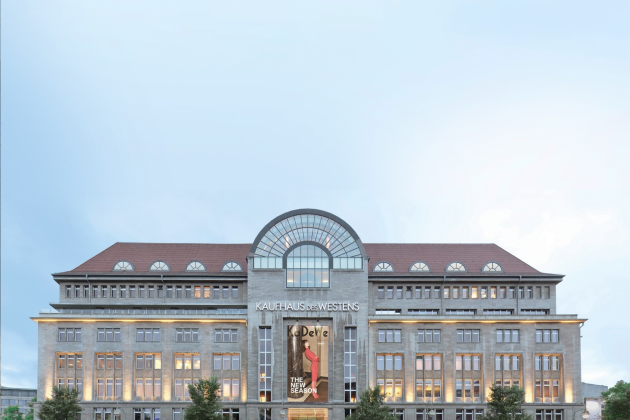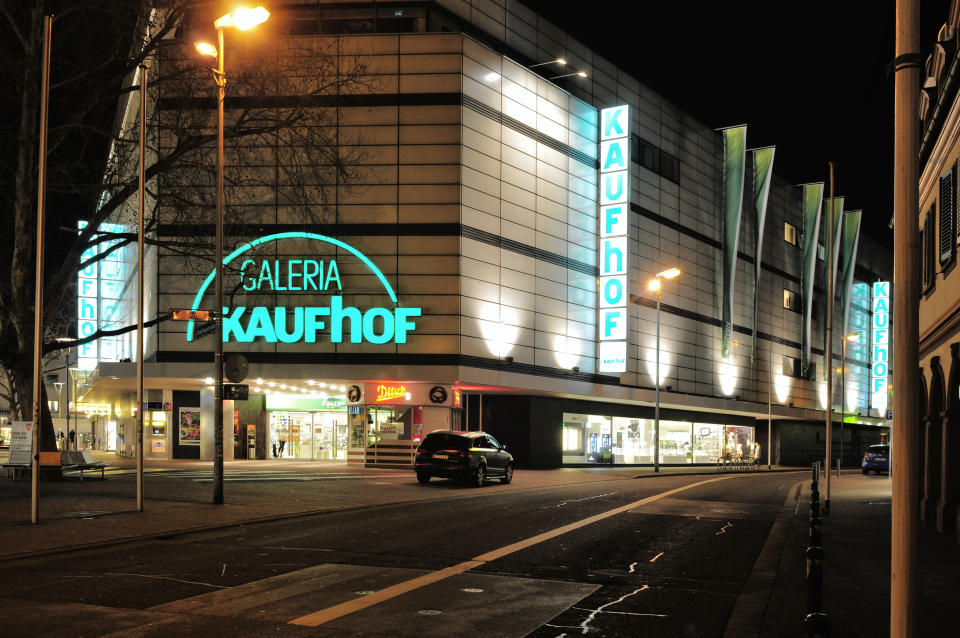What’s Going Wrong With German Fashion?

Earlier this week, the company controlling some of Germany’s grandest department stores revealed it was insolvent.
The KaDeWe Group, which manages the KaDeWe department store in Berlin, the Alsterhaus in Hamburg and the Oberpollinger in Munich, blamed exceedingly high rents and the financial collapse of one of its two co-owners, Signa Holding of Austria, for its financial woes.
More from WWD
Various suppliers — including Germany’s VKE Cosmetics Association, whose members include the L’Oréal Group, Estée Lauder and LVMH Perfumes and Cosmetics — say KaDeWe has been slow paying some big bills lately. The VKE sent a letter to the store management at what is arguably one of the country’s most prestigious retailers but received no reply, German news agencies reported this week after the insolvency announcement.
There’s more to the insolvency than that, too, with speculation about a breakdown in the relationship between Signa, which owns 49.9 percent of the company, and Thailand’s Central Group, which holds the other 50.1 percent stake.
But this isn’t the only bad news coming out of Germany’s fashion sector. Over the past few months there has been what the locals have branded an “Insolvenzwelle” or “wave of insolvencies.”
This wave has been headline-making because it has included some of the biggest names in German fashion retailing and production, including Peek and Cloppenburg, Gerry Weber, Reno, Ahlers, Peter Hahn, Madeleine, Hallhuber, Salamander, Klingel and Görtz. Smaller brands that recently declared themselves insolvent included Lala Berlin and bag maker Bree, while other members of the ill-fated Signa family — one of the biggest department store chains in Europe, Galeria Karstadt Kaufhof, and Signa Sports United — also did so.
Insolvencies among apparel sector companies that generate more than 10 million euros annually have tripled since 2022, German management consultancy FalkenSteg noted this month. In 2022, there were just 11 such insolvencies but last year there were 33.
And, FalkenSteg researchers added, “across all [fashion] company sizes, the numbers [of insolvencies] rose sharply for the first time since 2020, to 160 cases.” That’s 57 percent more than in 2022, they said.
All this is happening at the same time as Germany’s economy is slowing and consumer sentiment is increasingly depressed. German national income — gross domestic product — shrank by 0.3 percent in 2023. It was the only European economy not to grow last year, and this year isn’t expected to be much better.

German consumers are also unhappy. “Both economic and income expectations as well as the willingness to buy are showing noticeable declines,” the country’s largest market research company, GfK, concluded at the end of January. German shoppers are worried about inflation, much less willing to spend and want to save more right now, GfK said.
They’re also less willing to spend on fashion, the German Retail Federation reported last summer, and prefer to save or spend on things like holidays.
It sounds bad. But is Germany’s fashion retail sector — the second biggest in Europe after the United Kingdom, worth around 70 billion euros annually — really doomed?
The short answer, as a number experts told WWD, is no.
“Simply put, it’s all a bit of an exaggeration,” said Jochen Strähle, a professor of fashion management at the Texoversum course run by Reutlingen University in southwestern Germany. “The textile and apparel trade has always been subject to change but it’s not going anywhere. What is happening at the moment is something of a turning point for the sector.”
“What we are seeing is the consolidation we have been expecting for several years,” confirmed Achim Berg, an expert for apparel, fashion and luxury with management consultancy McKinsey and Company, who is based in the central Germany city of Frankfurt. “That was something we expected to see when COVID-19 happened but it didn’t because of the subsidies and support the German government provided to retail in general, but also to apparel.”
Taken as a whole, fashion retail in Germany isn’t in trouble, sector observers agree, it’s just changing — and in a way that should probably have happened a while ago.
The country’s Federal Statistical Office recently reported the latest numbers available: Fashion sales actually grew by 9.3 percent in the first half of 2023, compared to the same period in 2022.
Local specialist publication TextilWirtschaft put the insolvencies into further perspective. Out of around an estimated 17,000 companies in Germany that sell or produce clothing, shoes and accessories, 160 insolvencies in 2023 meant that just under 1 percent of the total were in trouble.
Additionally, some of the current wave of insolvencies are not what you would call a genuine bankruptcy, said Leo Faltmann, director of FashionConsult, a business based near the city of Munster in western Germany, which specializes in strategy and restructuring for the apparel industry.
In Germany there are two kinds of insolvencies, Faltmann explained. One sees the court appoint an administrator, who then controls the company’s assets, dispensing of them in order to pay back creditors. The other is “a self-administrated insolvency,” which is similar to an insolvency filed under Chapter 11 of the U.S’ own bankruptcy code. Just as with a Chapter 11 filing, in Germany the troubled company’s management retains control of assets and is able to restructure and renegotiate things like rental contracts, with the objective of returning to some sort of financial equilibrium.
According to TextilWirtschaft’s research, around a third of the redundancies in 2023 were self-administrated insolvencies. “If you look closely at some of the bigger insolvencies, they have chosen self-administrated insolvency,” Faltmann added. “So in some ways, the idea that there is some spectacular wave of insolvencies has been exaggerated.”

Analysts say there are a number of reasons behind the recent insolvencies. Some are beyond the control of local fashion retailers and producers. These include rising energy costs as a result of the war in Ukraine, which has led to mild inflation and a slight recession. This in turn translates to higher costs in everything from raw materials to wages. Rents have also continued to rise, with almost half of German retailers recently telling pollsters they felt particularly disadvantaged by these increases.
Additionally, political and social unrest — war in Ukraine and the Middle East, environmental challenges and dissatisfaction with the current German government — is weighing heavily on German consumer sentiment.
But there are also other reasons for the insolvencies which have more to do with long-running structural weaknesses and unsustainable strategies in the sector.
During the pandemic, the government brought in extra financial support and also suspended rules that said local companies must file for bankruptcy within a certain period after they realize there’s a problem, FashionConsult’s Faltmann told WWD.
“The companies that were not profitable before were, in principle, being supported by the state during the pandemic,” he said. Local insolvency reporting rules returned to normal in May 2021 and state support as part of the government’s Economic Stabilization Fund ended in June 2022. Tightening credit conditions and higher interest rates also made it harder for businesses in dire straits to refinance themselves after state support dried up.
Business models that had been challenged by issues like the rise of online shopping and the decrease in brick-and-mortar footfall, but had not done enough about them, are the ones fighting for survival.
“So we have all these insolvencies piling up,” Faltmann added. “But really it is structural change to the sector that is badly needed.”
For example, Germany has far too much inner-city shopping real estate, Faltmann said. Although the number of consumers going to brick-and-mortar stores plummeted during COVID-19 lockdowns, customer footfall in inner cities had been falling long before that, statistics show.
There were already a lot of empty storefronts in Germany’s smaller towns and cities. The pandemic saw even more of them and the trend becomes a vicious circle because, as observers say, the more of a concrete wasteland inner cities become, the fewer people want to go there.
The Signa Group’s many financial problems don’t help either. The Austrian real estate firm was responsible for the Galeria Karstadt Kaufhof chain of around 90 department stores — the chain has declared insolvency three times since 2020, received state bailouts of more than 700 million euros and previously had more than 170 stores. Anybody who’s ever visited smaller German towns and cities knows these are often a focal point in central shopping districts. Now they’re at risk. Some already stand empty.

So while the pandemic may have accelerated the trend for fewer shoppers in town, it didn’t create it.
After all, the share of online apparel sales in Germany has been growing for years and German online giant Zalando has benefited from this. Around 40 percent of all sales of fashion and accessories are now made online in Germany.
Asked whether Germany’s apparel sector has perhaps fallen behind other European nations or is more conservative in some way, Reutlingen University’s Strähle doesn’t think so. “Germany is the largest clothing market on the European continent, with some tough barriers to entry, which makes local producers and retailers more cautious about questioning their business models,” he suggested. “If you want to try something different, it’s a big deal and a lot of money. So people are less likely to experiment.”
McKinsey’s Berg also pointed to how the sector as a whole has developed over the past 10 to 15 years. “If you look at the top line development of the industry over that period, it’s all flat at best, with 1 to 2 percent growth or decline most of the time,” he told WWD. “So the industry as such is not growing. This means if you want to be successful in this market and you want to grow, you need to grow at the expense of somebody else.”
In particular there is pressure on mid-price apparel, Berg noted, with categories like premium and affordable luxury eating into that market from the top, then value and discount clothing pushing into it from the bottom. Many of the big-name German insolvencies are from the midmarket category.
In other words, Berg argued, the German market is very competitive. “And I think the reality we have now is not coming by surprise. Apparently some players have not taken care of their homework when it was due.”
At the same time, this will open up opportunities in Germany, Berg argued. “There are always pockets of growth,” he concluded. “If you look at the last five years, you see how sports was one of those pockets, casualization was another, so were sneakers. So there is always something in fashion. And if you have that consolidation in German apparel, and there are some not very competitive formats and players that are exiting, that also creates opportunities for other players to gain market share or compete in that segment.”
Best of WWD


